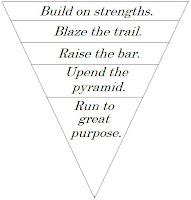So much of what we do as organization leaders is the old command and control model. Decide the strategy and cascade the plan to every level. Some staff, customers and suppliers buy into such plans, but many do not.
But what if it was possible to allow the new strategic directions and the action plans to emerge organically through the interplay of people within the organziation so they own the strategy? Would the plan be any different?
The answer is yes. But different in a surprising way. When you connect the capacities and interests within a group systemically, new-to-the-world possibilities emerge aligned to the needs of the people AND the organization. They become valuable imperatives for both.
Such was the case in Pittsburgh, Pennylvania in late July 2009, when some 30 community leaders came together to explore how they could continue to build upon their work and their newly acquired skills as serving leaders.
It was a coming together of three different cohorts who only knew members of their own group, although they shared a common purpose as serving leaders.

The Serving Leader program was developed by business consultant Ken Jennings and inner-city non-profit champion John Stahl-Wert. It is a unique action-centred “life’s journey” approach to leading by serving the interests of others. It has five aspects. Build on strengths. Blaze the trail. Raise the bar. Upend the pyramid. Run to great purpose. It’s older than Methusalah!
The session that was to occupy the morning and early afternoon was designed by Abby Straus, leadership coach, facilitator and cultural creative and Amy Skolen, organization development consultant who works as a kind of horse-people whisperer.
We were using a whole bunch of wireless keyboards connected to a computer and a display so we could discuss and then respond to questions presented on the screen. After a few warm-up activities we worked in pairs to explore the warmth and power of the connections of people within the cohorts, then shared our ideas with the entire group. This served as a useful introduction of people to each other and revealed the culture/essence of this fledgling community.
Next each pair interviewed a partner about their strengths and introduced them to the whole group. But before the introductions we foreshadowed the next question so people could pay attention to the strengths that could complement their own.
What happened next obeys the laws of complexity theory. Biologist Stuart Kauffman shows that when you connect about half of the active agents in a system new order emerges through a kind of cross-catalytic effect. People then identified who they would like to join with and why they were complementary. As numerous cross-connections were made, a powerful sense of purpose began to emerge together with an outpouring of simple but doable action plans and commitments to make it happen.
For the grand finale, the group crafted the words of a collective Gregorian Chant, a few words that captured the essence of their new “great purpose”. We gathered around the screen to sing the words, first solo, then sotto voce until every voice was heard. The voices rose in volume and exuberance to a celebratory full-throated choral crescendo. Then a beautiful silence.
The words were both a powerful statement of group intent and feedback about our collective co-performance as participants and facilitators.
Here’s a sample of what we crafted and chanted:
* Tremendous transforming testaments to timeless truths!
* Opening the onion of opportunity.
* Merging motivations of members in a momentous movement.
* Agents of impact for the renewal of culture.
* Connecting pieces of the puzzle together to reveal the Divine.
* Many minds making marvelous music.
You can use this workshop method to explore how to serve each other’s interests:
1. Honoring each other – In what fabulous way has another person in your group, touched, inspired or challenged you. Who and what did they do?
2. Discovering possibilities – Ask your partner to describe 3-5 valuable strengths, capabilities or resources they bring to the world. Write a 25-word description of what you have just learned/discovered.
3. Making connections: Choose one or two strengths that are in the room and explain how your collective strengths could be leveraged to start a really important project, program or activity in the community beyond what you could do alone. Give an example.
4. How would you like to be served by the group. Describe the kind of support you would like to give/offer.
5. Knowing how people would like to be served by the group, how do we make that happen?
6. What is happening in your life/business/community etc. that you would like help with?
7. Thinking about the ideas we have generated for taking our organization/group forward and our individual requests in the group, where do you feel drawn to commit, and what will you commit to doing?
8. Create a 5-6-word snazzy slogan/song of OUR GREAT PURPOSE. e.g. exceptionally exotic expressions of eager earthbound essences. Use allitration, metaphor, rich words etc.




